Mind's Eye Theatre: Laws of the Night by RocknRollaAyatollah
Introduction: “You’re not making fun of me, you’re making fun of my LARP character.”
Original SA post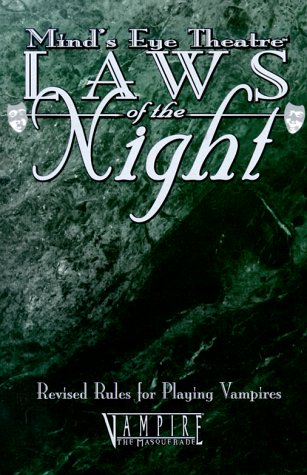
Introduction: “You’re not making fun of me, you’re making fun of my LARP character.”
Though it comes up from time to time, no one has really gone into depth about the old Mind’s Eye Theater system of LARP books for White Wolf’s game lines. This system was used for the over decade until the new By Night Studios book came out and is being replaced by a much better system. There was a book or books put out for each of their game lines, except Demon, and they were all still played up until recently. Those games though were hilariously bad in many regards but have their diehard fans.
For this review of the Mind’s Eye Theatre, Laws of the Night book, I’m going to start with a breakdown of “larping” and the organizations involved in it.
What is LARP?
LARP is Live Action Roleplaying and it’s generally any game where you stand around and act out what your character is doing within reason. In the MET games, there are strict no touching rules and everything is resolved through challenges, which we’ll get to in the general rules breakdown. Since most White Wolf games take place in the modern world, you don’t have to dress up like you do for medieval larps. Personally I also think that a 500 year old vampire would just dress up like a normal person because if you walk around looking like Dracula or a foppish Anne Rice character, even people in the grim World of Darkness are going to raise some eyebrows and you wouldn’t have lasted 500 years.
Why LARP?
I think the big question is, why you would do something this nerdy and embarrassing when you could just play tabletop in anonymity? The answer for MET is that the dynamic of the games is completely different from those in tabletop. Instead of the structure of the city or local supernatural organization being made up of NPC’s, it’s usually made up of player characters. So in Vampire the Prince or the Sheriff would be a player character and that creates a whole new political dynamic to the game that isn’t present in tabletop. There’s also less of a group dynamic and it’s easier play a backstabbing asshole since you don’t have to worry about alienating a friend at the table.
How are these organized?
There are two types of organizations, troupe and national clubs.
Troupe is usually that your game is a standalone game. Though there might be plotlines that reach outside the city, most stuff outside the city are done with NPC’s. This can be good for a number of reasons which will touch on with the clubs but limits things to a degree. When I started, I played in a local troupe game that was most of the younger regulars at my FLGS and it was a good game. Not many problems with people, no creepy people, and just an all-around good time. This is dependent on the group though and it can very easily be the opposite of this.
National club games are run within a usually national or international organization. The biggest and longest running one is the Mind’s Eye Society, which used to be called the Camarilla. The Camarilla was founded in 1992 and eventually got taken over by White Wolf after a legal fiasco. The organization tried to sue White Wolf over the copyright of their own properties and got taken over for their delusional behavior. This should give you a good idea at the level the people running this organization are at. In 2010, White Wolf dropped the organization and now they are independently run. There are similar organizations out there like One World By Night, which is pretty similar to the Camarilla in terms of what you get good and bad.
So why play with these guys? You would mostly play in one of these games because it offers at least a nationally connected game. If you want to travel to a nearby city and play in their game for one weekend, you can. If you have problems with a character from out of town, you can talk with the leadership of their city and get things done. There is international interaction between people and there are big con games. In theory this is pretty cool but in practice it’s a headache.

The character Alex Montoyez from Cincinnati, Camarilla's conclave at Milwaukee, 2006
The Camarilla itself is an organization that has a paid membership system, when I played it was $20 a year and membership is restricted to 18 and up. The organization though never checked ID and I joined the organization when I was 16, no questions asked. Once you’re a member, you start out at membership level 1, this could go all the way up to 15 though it was rare. Your membership level gave you more starting experience points. You could raise this level by running games and doing community service but people often cheated at the latter. This will become important when we get into specifically why Laws of the Night is a garbage system for Vampire. There was also an approval system that offered checks on characters and went up to the international or top level. Within the Camarilla chronicle, some character types are restricted. In theory this is done so that you don’t have a million rare character types running around. So if you want to play your purple eyed, white haired Salubri who is one step away from Golconda, you have to get multiple top approvals to play it. This means you have to get approval from your storyteller, your chapter’s storyteller, your region’s storyteller, your national storyteller, and the head of the organization because there are only a very limited of Salubri in stock Vampire the Masquerade and Golconda is pretty much close to impossible. The Camarilla is all about who you know though so if you’re friends with the national level storyteller and everyone in between, you’re good on your Baali vampire with Thaumaturgy or your Lasombra Antitribu. There were people as well who would constantly flaunt this and should have been allowed to play some of the things that were running around.
One of the problems with organizations like the Camarilla is that anyone can play and you kind of have to let them. Like the RPGA or Pathfinder Society, this attracts the people who can’t get a regular gaming group because they’re social pariahs and usually for good reasons. People in the Camarilla also took things way too seriously. The amount of real life vendettas that evolved from in game slights or actions done by characters was insane. Chapters usually ended up destroying themselves sooner or later. There are rules that are made to prevent griefing but people get around them very easily. Someone killed your character, tell your friend who lives in Minneapolis with a member class of 12 and an elder vampire he’s been playing for 5 years. The person who wronged you will soon get dealt with and it’s perfectly ok because that elder has a perfectly good reason for what he did. Technically ST’s are allowed to disallow people from bringing their game breaking characters to games or sending them in proxy but in practice it never happens for those reasons. Those people, who might be connected will complain, you might get audited, your characters might get killed off, and you might have future approvals denied for reasons. This didn’t happen as much for proxies but when someone drives two hours to your game, you can’t really turn them away without feeling like an asshole. It’s all very petty and childish but then again this is an organization that sued the maker of the game they play for the intellectual property rights to it.
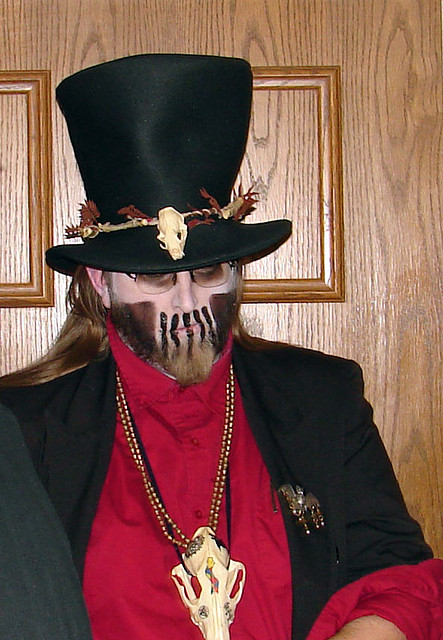
The character Papa Sallow Rose, Camarilla's conclave, Milwaukee 2006
Up next, the basic rules of the original MET system.
*Images courtesy of wikipedia, I don't actually know those guys.
Basic MET Rules: The Economics of Inequality
Original SA post
Basic MET Rules: The Economics of Inequality
The rules that the Mind’s Eye Theatre system uses aren’t the best truth be told and all the game lines use it. For some, like Werewolf, it’s not that bad but for Vampire it’s really bad.
The system works on a system of traits that are capped at a certain number based on your power level. For mortals, the cap on traits is 10, abilities is 5 for most, and magical powers are capped by power level.
Traits are the characteristics of your character. They are divided into physical, mental, and social traits. In most games these are represented by a number value but in MET they’re actual traits. You can be dexterous , agile , brawny , or knowledgeable for instance. When challenges are attempted, you have to bid an appropriate trait and make a test. This test is handled with throwing rock/paper/scissors. Once the test is resolved, you either succeed or fail. Ties go down to the number of traits you have, this is important so keep this in mind for later. If you fail, you can get a retest by spending an ability point or from a supernatural power. Abilities are generally the same as in tabletop but give you a retest. Traits are temporarily lost on a failure and once abilities are used they are temporarily gone. Traits in a single category can be refreshed by spending a willpower trait but you can only do that once per session. So unlike in tabletop, you can’t go on forever. If you have double the number of traits than your opponent, you can retest a challenge because you’re that much more powerful than them.

It goes without saying that using rock/paper/scissors is stupid because it’s as much a game of skill as it is chance. It’s also really easy to cheat at rock/paper/scissors. If you know how the person you’re throwing against thinks, you can beat them. I know that this is not very easy but some people really do go into Bart Simpson mode and think nothing beats rock. This can also be modified if you have potence, which can give you the bomb. The bomb is a thumbs up that can only be beaten by scissors. Only vampires to my knowledge cam gain access to this mechanic.
In tabletop, there’s an element of random chance and dice can explode. A neonate vampire still has a chance against an older vampire but in MET that’s not the case. Since there’s no real chance mechanic and because dice aren’t being used, it’s just static numbers and the luck of the draw in rock/paper/scissors.
Since traits are tied to your level of supernatural power, you’re screwed as a lower power character going up against a higher powered one. In Werewolf for instance this is ok because Werewolves can go up in rank and climb the ladder of spiritual power. The same is true for most other supernaturals. This is not true for Vampires in Masquerade. Vampires have a mechanic called generation which represents their connection to Caine, the original vampire. Caine’s children were the 2nd generation, their children were the clan founders, and this goes all the way up to the 13th generation. There are 14th and 15th generation vampires but they’re barely vampires and are a sign of the nearing apocalypse.
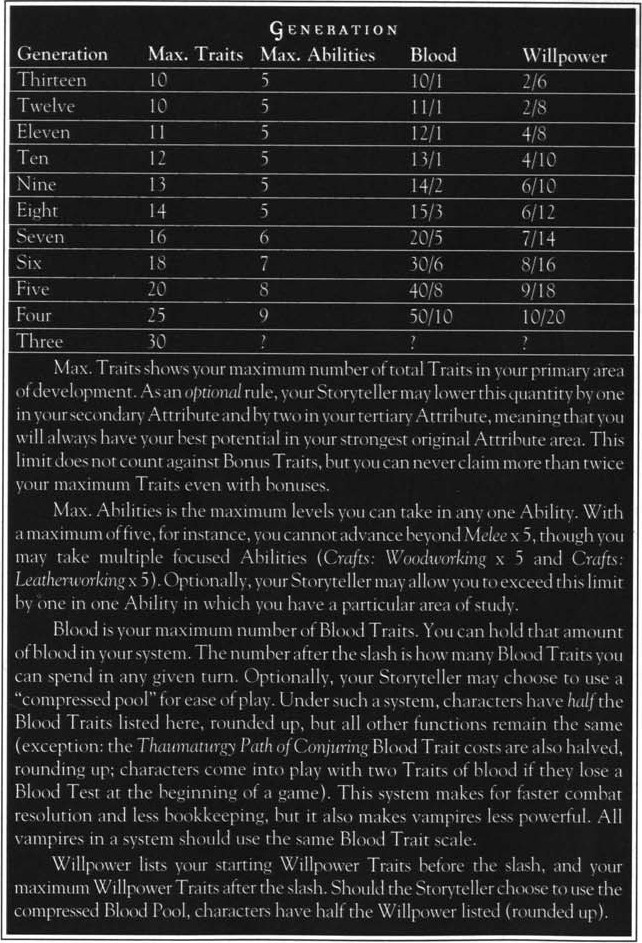
Vampires have blood traits. Normal humans have 10 blood points and as vampires go down in generation, the blood becomes more potent. The number doesn’t represent the total amount of blood the person has but its relative power and how much it satiates a vampire’s hunger. The number on the left is the total number of blood points and the one on the right is the amount that can be spent a round. Disciplines usually use blood points so it limits the number of disciplines you can use a round. The Path of Blood Thaumaturgy path can temporarily lower the caster’s generation but the only way to do this is permanently is at character creation or through diablerie. Diablerie is an act by which a vampire devours the soul of another vampire. If the vampire being diablerized is lower generation, the offender’s generation will be lowered by one step and they might gain a free discipline. They also gain two free experience points because they have to make this crime more worthwhile. Diablerie is a crime universally punished by destruction and can be detected by reading a vampire’s aura with auspex.
In an organization like the Camarilla, you would have players constantly rolling in with at least 8th generation characters with 50+ XP at character creation because they had high member class. A person who just started playing’s character by default can’t even think about stepping up to that level. The theory was that this would cause there to be a greater variety in gameplay but in reality it just made an old boy’s club where the same people were always at the top regardless of how they played.
Part 1: What Faction Should This Game Be Based Around? The Correct Answer is Camarilla. Always Camarilla.
Original SA post
Part 1: What Faction Should This Game Be Based Around? The Correct Answer is Camarilla. Always Camarilla.
For this section, we’re going to talk about the factions you can run a chronicle around. There is a book for the Camarilla, Sabbat, and Anarchs but they aren’t really needed to tell the truth. The first two have some bloodlines, disciplines, thaumaturgy paths, and the Anarch book has some combo disciplines but this is all extra. With the Sabbat guide you get into all the rare and somewhat powerful bloodlines of the Sabbat but they’re not really good for PC’s. Yeah, you could play Kiasyd but you’ll probably never come out of your reading room and to be honest if you want to read, just read because it will be more rewarding than most LARPs.
Vampire or Cainite History 101
As mentioned before, Caine was the first vampire. There’s a good deal of stuff in the WoD prehistory that is up for debate but Caine is 100% the progenitor of all vampires. Caine, cursed by God for the murder of his brother uses his curse to embrace the 2nd generation so that he could have a family. Those children embrace the founders of the dark ages and modern clans. This period of time is shrouded in a good deal of ambiguous mystery and what became of many of these figures is of heated debate. Well into Dark Ages: Vampire some of the 3rd generation are still around and active.
Most of the 3rd generation set up shop in specific geographic areas and began having children of their own. The 4th generation, methuselahs, are incredibly powerful, detached from their humanity, and known for their capricious natures. An example of this is Mithras, who I posted in the art thread. He claims to be the Mithras, a bunch of other supernaturals do though so no big deal, and he was the leader of London until the Blitz knocked him into torpor. Before the time of the Reformation, vampires often did not hide their true natures and lorded over humanity. This is of course dangerous but mortals be damned, time to be an undead king/queen with all the swagger that comes from being a godlike baller or boss bitch. Humanity though, is beginning to regroup. The social order of Europe is changing as well, the Catholic Church is losing influence over everyday life and the Order of Reason is beginning to be formed. They’re the progenitors of the Technocracy but oddly enough they’re not the catalyst of what happens next.
With the founding of the inquisition, the Catholic Church is beginning to find evidence of vampires and other supernatural creatures. The Catholic Church deals with them like they deal with most issues relating to the heretical, eliminating them with extreme prejudice. Elders, realizing that the jig is up begin throwing their childer at the inquisition, hoping that the inquisition will think that they’ve killed the evil vampire lord they’re after. The childer though, don’t like this and the Anarch Revolts begin.
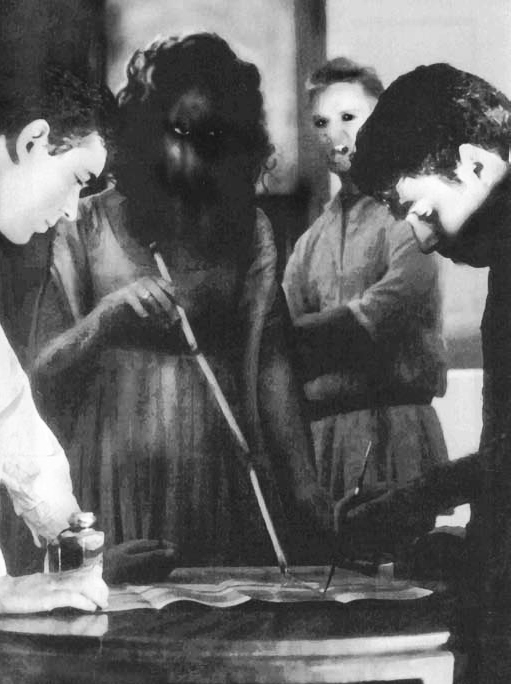
I'm tired of your shit Pepin!
The Anarch Revolts are like the vampire version of the Wars of Religion and the English Civil War. The Brujah initially lead these revolts but it spreads to other clans. Upstarts like the Tremere move to capitalize on the situation, the Giovanni usurp the clan status of their Cappadocian masters, the Assamites get involved, the Lasombra and Tzimisce diablerize their founders, and the chaos of the time leads to great upheaval for everyone.
The hostilities are ended by the Convention of Thorns. The Camarilla is founded to act as a vampire Illuminati, to ensure that what had just happened never happens again. The Sabbat is formed by the Lasombra and Tzimisce who don’t want to join the Camarilla, and some less hardcore vampires keep fighting for the Anarch cause though they’re usually considered members of the Camarilla. The Tremere enforce the peace on the Assamites by cursing them and earn themselves a place in the Camarilla. The indepdendent clans remain independent because they’re dirty necrophiliac mobster necromancers, gypsy stereotypes, and Conan villains.
Factions
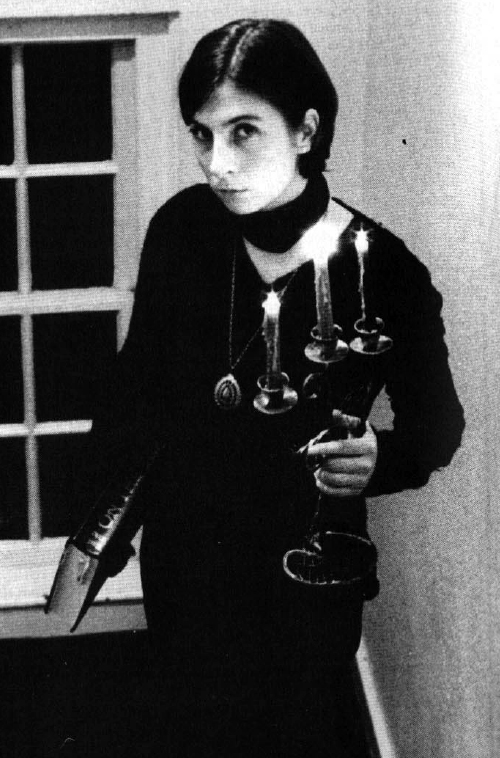
What do you mean I have to make a frenzy check for being this close to an open flame?
The Camarilla
The Camarilla is the standard for a vampire game. Laws of the Night pretty much assumes that this is the faction that you will be going with. They have all the standard clans, they’re pretty average vampires, and they have the most stable structure. Camarilla domains are ruled by a Prince and they usually answer to the Inner Circle, though this is rare. A Prince is served by his Seneschal, Sheriff, Whip, occasionally Scourge, and maintains a Primogen council composed of clan representatives. All of these positions should normally be maintained by player characters but that might require more players than you have. Each of these positions carries different status traits that show your character’s political power. Someone who has more traits is generally considered to be more powerful than another character. Camarilla society also operates on the exchange of boons, favors redeemable for help or aid when asked for it. All and all, it lends itself to less conflict than the other factions.

She might look normal but her backstory is probably that she's a Nazi race doctor or murders special needs children.
The Sabbat
The Sabbat originally began in 1st edition as bogeymen, shadowy urban legends told to frighten neonates. In 2nd edition, they evolved into gangs of serial killers and in Revised they evolved into serial killer survivalists. The Sabbat believe that they are the true heirs of Caine and that the antediluvians, the 3rd generation, should be killed because they wronged Caine. The Sabbat operate in packs and practice the vaulderie, a ritual where they bleed into bowl as a group and drink from it. This bonds them together as a pack and prevents them from being blood bound. They do have a lower level blood bond to the pack as a whole but they won’t be committed to a single master. A pack is led by a Ductus and there are positions such as the Priest, manages the rites, and the Abbot, who manages their communal haven. Sabbat domains are administered by a Bishop, who answers to an Archbishop, and who in turn answers to a Cardinal. Under the cardinals are a Priscus Council who work as a board of regents like the Primogen. There are positions in between but I won’t go into them because they’re not as important. The Sabbat have many rituals, some festivals, and "games" that they play that are set up like slasher horror movies.
Sabbat games are problematic because they attract people who like playing chaotic stupid characters. The Sabbat is also an antagonist faction so they tend to be more broken than the Camarilla and Anarchs. Among the packs they share disciplines, even in clan disciplines like Obtenebration and Vicissitude, and since they work as a group they’re stronger than individual vampires. The Sabbat also has Assamites and pretty much every bloodline you can think of other than Tremere Antitribu, they were wiped out for balance, and because of that they’re a beacon for power gamers. Due to the organization of the Sabbat, you also need a good number of players for an all Sabbat chronicle.
"EDIT Addendum: Sabbat Factions" posted:
The Sabbat has several factions.
The Black Hand
The Black hand are the stormtroopers of the Sabbat. They are usually ideologically dedicated to the Hand and the Sabbat as a whole. They are loosely related to the True Hand, of Dirty Secrets of the Black Hand, and are much more organized than the Sabbat as a whole. They usually do assassinations and commando raids on the Camarilla and have special moon tattoos on their hands.
The Inquisition
The Sabbat Inquisition are set up to root out infernalism within the Sabbat. The Sabbat might be made up of monsters but they're not infernalists. I guess even a sect that recruits people by hitting them over the head with a shovel, embracing them, and burying them has to have some standards.
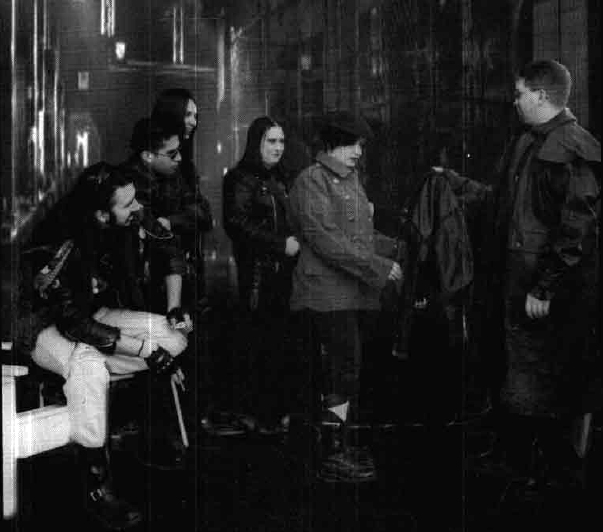
How much flair is on that coat? No patches? I don't think you're cut out for this movement.
Anarchs
The Anarchs are the Washington Generals to the Harlem Globetrotters of everyone else. They once controlled California but got their collective shit kicked in by the inscrutable celestials known as the Kuei-Jin, whoever came up with that name deserves to be publicly shamed. Anarchs don’t really follow a set make up though there are usually Barons, who are like warlords, and the domains tend to be made up of gangs. Anarch gangs are usually not as well organized or devoted as their Sabbat counterparts. This is mostly because the vaulderie makes Sabbat vampires into cult fanatics. There are positions under Barons and among gangs but to be honest they don’t really matter. Anarch vampires tend to be neonates as well and most leave by the time they reach higher status. It’s essentially like being that 30+ year old guy at the punk show, getting mad at people for being rowdy, and then leaving after some kid gives you shit for a stupid reason. The Anarchs have combination disciplines, called devotions, and though they are cool, they are prohibitively expensive and you’re going to get decapitated by a shadow tentacle wielding a parking meter before you can reach optimum efficiency. Also, you have to find someone who knows the devotion to teach you so good luck with that.
Part 2: Rich (Vampire) Dad, Poor (Vampire) Dad
Original SA post
Part 2: Rich (Vampire) Dad, Poor (Vampire) Dad
Let’s talk about experience costs. Some would probably think we should talk about the clans since we talked about the different sects last update. We’ll cover the XP costs because it will go into the costs of disciplines and why some clans are just better than others.
The MET games have a very similar setup compared to their tabletop counterparts but a bit simpler. Generally a player is going to be getting about 5 XP a month and that’s usually after playing one to two times a month. If you play in the Camarilla or Mind’s Eye Society, you can see how Member Class (MC) is a big deal. Someone who is established within the organization can usually start up a character with almost a year’s worth of XP and is accruing XP at the same rate as all other players. XP costs are as follows,
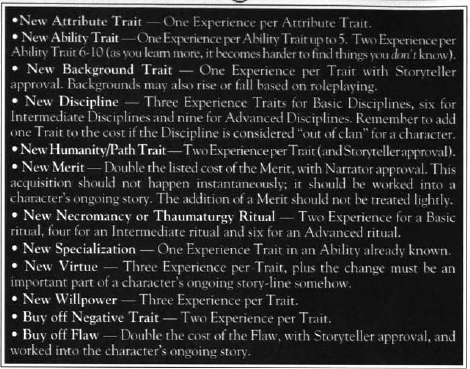
This is actually better than some of the other books' XP charts which omit costs for things like willpower.
Most things in game outside of out of disciplines are usually affordable with a month’s worth of XP. As you can see, abilities and traits are one point each. Usually people max these out at character creation with flaws, you’re normally allowed 7pts of flaws in most games. You usually have enough willpower at character creation and don’t need to buy more after the fact but can. Humanity is usually fine as well unless you’re a screw up or you’re converting to a path other than humanity, which you have to buy up.
Disciplines are the big point sink, especially ones like thaumaturgy or necromancy but thaumaturgy is so broken at times that it doesn’t even matter. Out of clan disciplines are disciplines not part of your clan’s discipline list and are more expensive. You usually have to get someone to teach you these disciplines and if it’s a special in clan discipline, they probably won’t teach you it unless you cash in a big boon. For instance to learn quietus outside of the Assamite clan they have to mess up on a hit that you put out, which is rare. Displaying use of a clan specific discipline can also get you into trouble with that clan if you don’t have a good reason for knowing it. For example, displaying thaumaturgy when you’re from a clan other than Tremere is a good way to get yourself reduced to ash. The Tremere don’t teach thaumaturgy outside of the clan and they’re so organized that they know all the people who would be allowed to learn it. You’d also be screwed if you got it from diablerie because it requires teachers and an occult library specializing in thaumaturgy to learn it. We’ll get into the particulars of thaumaturgy and necromancy once we talk about disciplines but if you’re familiar with tabletop it works about the same way.
The most important factor at character creation as you can see is your clan. For this reason you get some questionable character concepts because the player is working from the power set as a concept instead of the clan as a concept. The biggest offenders in this regard are usually Tremere players who play characters who would not have been embraced by the clan. You could argue that with a great backstory anything is possible, you’re wrong by the way, but the Tremere are the Google of vampire clans and they’re very particular with who they choose. They have a strict clan code they have to follow, a pyramid like structure with ranks, and even telepathic conferences. They’re probably not going to embrace a pyromaniac whose only ambition and knowledge is setting things on fire.
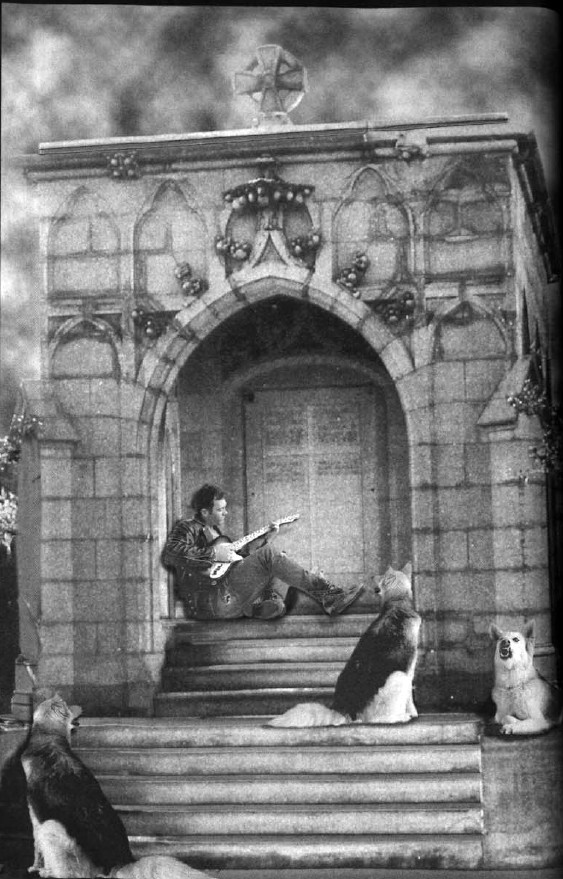
Man can hope, dream even, and sometimes his dreams can come true.
Next up: MET disciplines, like your tabletop disciplines but different.